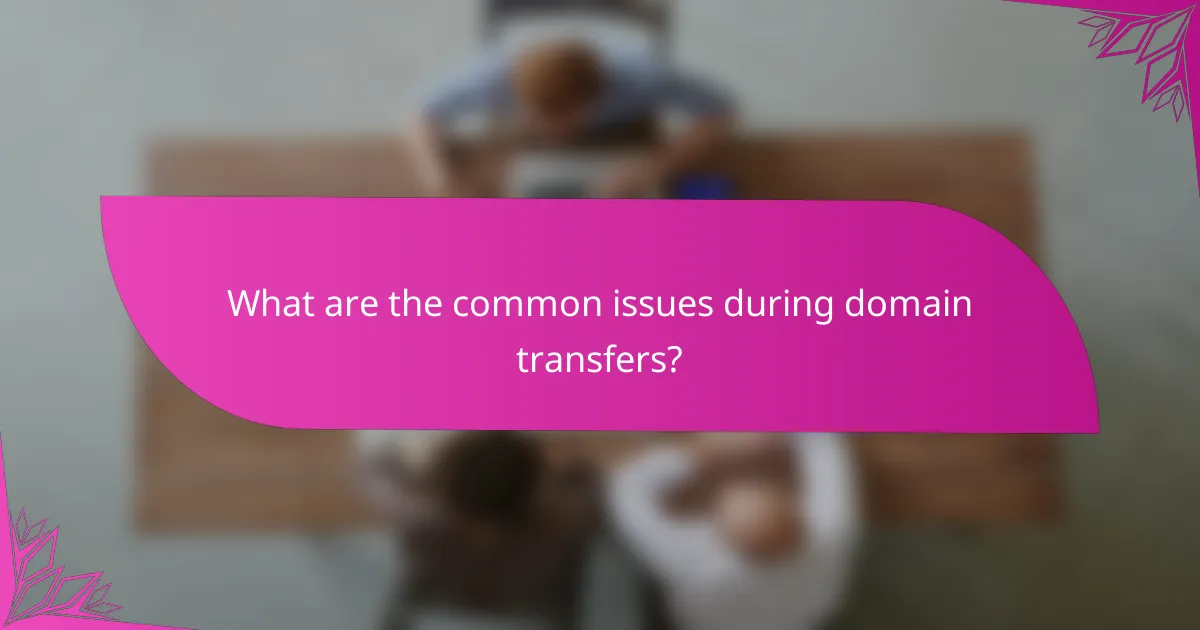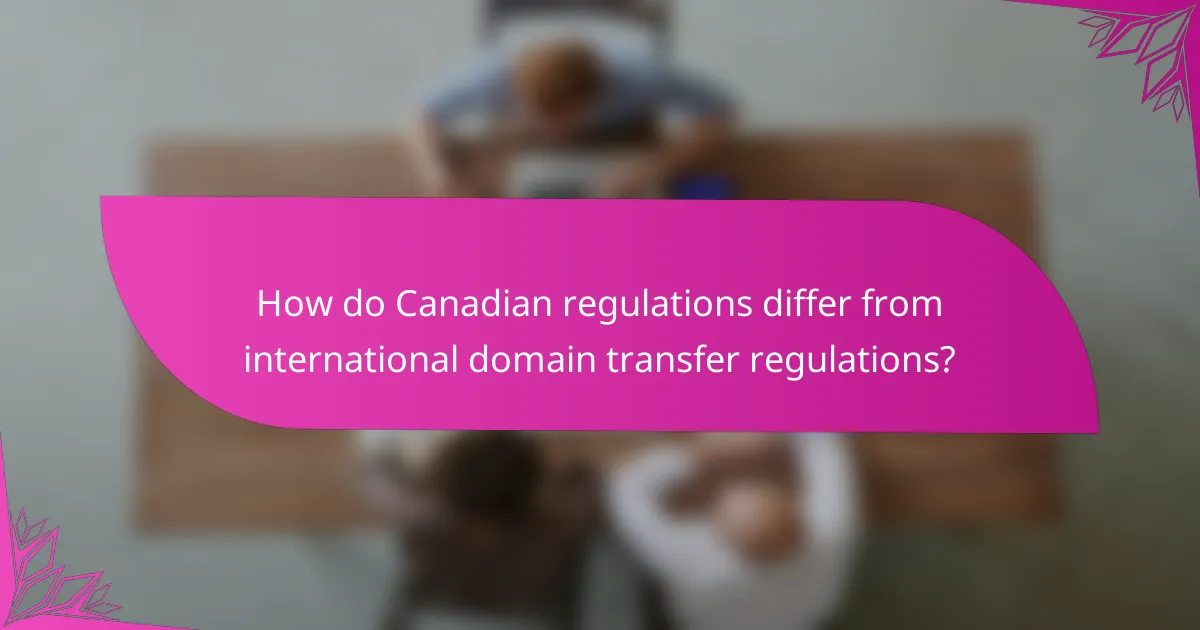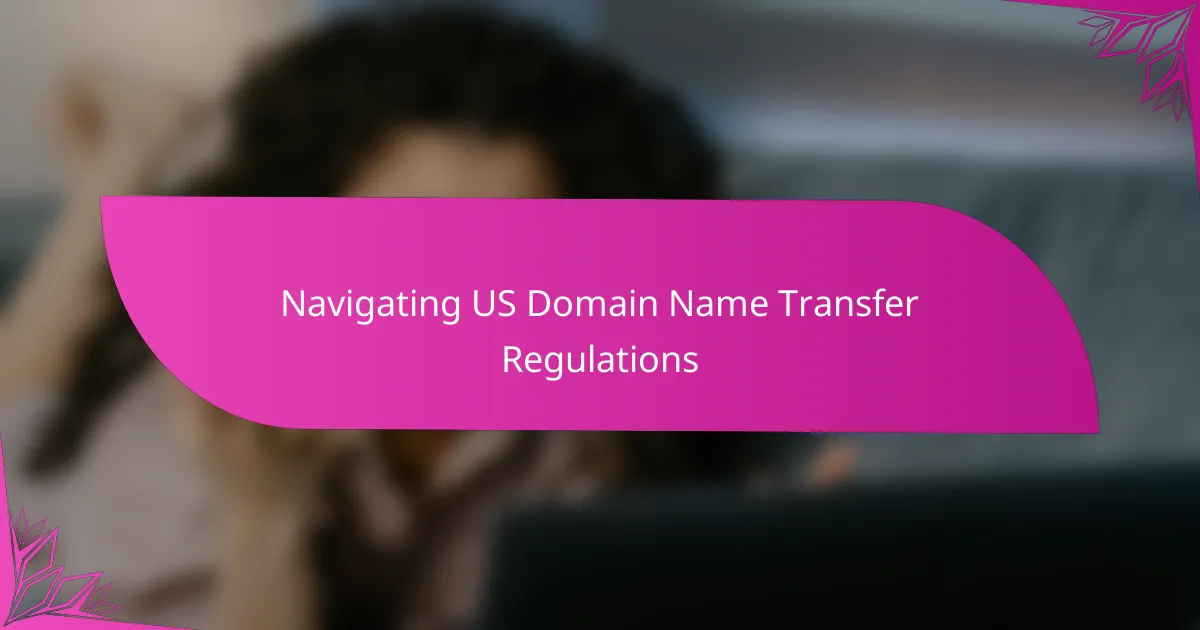Navigating the domain name transfer process in Canada requires an understanding of key regulations and steps to ensure a seamless transition between registrars. This includes unlocking the domain, obtaining an authorization code, and confirming the transfer via email, all while adhering to ICANN policies and individual registrar requirements. Being aware of common issues such as authorization code errors and domain lock status can help mitigate potential delays and complications.

What are the steps to transfer a domain name in Canada?
Transferring a domain name in Canada involves several key steps to ensure a smooth transition from the current registrar to the new one. This process typically requires unlocking the domain, obtaining an authorization code, and confirming the transfer through email.
Initiate the transfer with the current registrar
The first step in transferring a domain name is to initiate the process with your current registrar. Log into your account and look for the option to transfer your domain. Some registrars may require you to contact their support team to start the transfer process.
Ensure that your domain is eligible for transfer, which usually means it must be at least 60 days old and not recently transferred. Check your registrar’s specific policies for any additional requirements.
Unlock the domain and obtain the authorization code
Next, you need to unlock your domain to allow for the transfer. This is typically done in your registrar’s control panel under domain settings. Once unlocked, request the authorization code, also known as an EPP code, which is essential for the new registrar to process the transfer.
Keep this code secure, as it is a critical part of the transfer process. If you do not receive the code promptly, check your email settings or contact your current registrar for assistance.
Submit the transfer request to the new registrar
After obtaining the authorization code, go to the new registrar’s website and submit a transfer request. You will need to provide the domain name and the authorization code during this step. Most registrars will guide you through the process with clear instructions.
Be aware that some registrars may charge a transfer fee, which often includes a one-year renewal of your domain registration. Review the terms before finalizing the transfer.
Confirm the transfer via email
Once the transfer request is submitted, you will receive an email from the new registrar asking you to confirm the transfer. This step is crucial, as it verifies that you are the rightful owner of the domain and wish to proceed with the transfer.
Check your spam or junk folder if you do not see the email in your inbox. You typically have a limited time to confirm the transfer, so act promptly to avoid delays.
Wait for the transfer to complete
After confirming the transfer, you will need to wait for the process to complete, which can take anywhere from a few hours to several days. During this time, you may receive updates from both your old and new registrars regarding the status of the transfer.
Once the transfer is finalized, you will receive a confirmation email from the new registrar, and you can then manage your domain through their platform. Make sure to review your domain settings to ensure everything is configured correctly after the transfer.

What are the key regulations for domain name transfers in Canada?
The key regulations for domain name transfers in Canada are primarily governed by the Internet Corporation for Assigned Names and Numbers (ICANN) policies and specific requirements set by individual registrars. Understanding these regulations is crucial for ensuring a smooth transfer process and avoiding potential delays or complications.
ICANN transfer policies
ICANN transfer policies outline the standardized procedures for transferring domain names between registrars. These policies require that the domain name must be at least 60 days old and not previously transferred within the last 60 days. Additionally, the domain owner must provide authorization for the transfer, typically through an authorization code.
It is important to check the specific ICANN policies that apply to your domain extension, as some top-level domains (TLDs) may have additional requirements. Familiarizing yourself with these policies can help prevent issues during the transfer process.
Registrar-specific requirements
Each registrar may have its own set of requirements for initiating a domain transfer. Common requirements include unlocking the domain, providing an authorization code, and ensuring that the domain’s contact information is up to date. Some registrars may also require confirmation via email from the domain owner.
Before starting a transfer, review your current registrar’s guidelines to ensure compliance. This can help avoid unnecessary delays and ensure that you have all the necessary information ready for a successful transfer.
Domain lock status regulations
The domain lock status is a security feature that prevents unauthorized transfers. When a domain is locked, it cannot be transferred until it is unlocked by the domain owner. Most registrars provide an option to lock or unlock your domain through their management interface.
To transfer a domain, you must first unlock it. Be aware that some registrars automatically lock domains after a transfer, so you may need to unlock it again if you plan to transfer it in the future. Always verify the lock status before initiating a transfer to ensure a smooth process.

What are the common issues during domain transfers?
Common issues during domain transfers include authorization code errors, domain lock status problems, and transfer delays due to registrar policies. Understanding these challenges can help streamline the transfer process and minimize disruptions.
Authorization code errors
Authorization codes, also known as EPP codes, are essential for transferring a domain from one registrar to another. If the code is incorrect or expired, the transfer will fail. Always double-check the code provided by your current registrar and ensure it is entered accurately.
To avoid errors, request the authorization code well in advance of the transfer. Keep in mind that some registrars may have specific requirements for generating these codes, so consult their guidelines for assistance.
Domain lock status problems
Many registrars implement a domain lock feature to prevent unauthorized transfers. If your domain is locked, you must unlock it before initiating a transfer. This process typically involves accessing your registrar’s control panel and changing the lock status.
Be aware that unlocking a domain may take some time to propagate, so plan accordingly. After unlocking, verify the status to ensure it is ready for transfer, as some registrars may have additional security measures in place.
Transfer delays due to registrar policies
Registrar policies can significantly impact the speed of domain transfers. Some registrars impose waiting periods after a domain is registered or transferred before allowing another transfer. Familiarize yourself with these policies to avoid unexpected delays.
Additionally, ensure that all contact information associated with the domain is up-to-date, as registrars may send verification emails that require prompt responses. Ignoring these communications can lead to further delays in the transfer process.

How do Canadian regulations differ from international domain transfer regulations?
Canadian regulations for domain name transfers are distinct from international standards primarily due to the oversight of the Internet Corporation for Assigned Names and Numbers (ICANN) and specific local laws. While many countries follow ICANN guidelines, Canada has additional requirements that can affect the transfer process, including identity verification and compliance with federal regulations.
ICANN vs. local regulations
ICANN sets global standards for domain name management, including transfer protocols that most countries adopt. However, Canada imposes additional local regulations that require registrars to verify the identity of the domain owner before a transfer can occur. This may involve providing personal information or confirming ownership through email verification.
Additionally, Canadian regulations may require compliance with laws such as the Personal Information Protection and Electronic Documents Act (PIPEDA), which governs the handling of personal information. Registrars must ensure that transfer notifications comply with these regulations, adding another layer of complexity to the process.
Country-specific transfer rules
Different countries have unique rules governing domain name transfers, which can vary significantly from Canadian regulations. For instance, some countries may not require identity verification, allowing for a more streamlined transfer process. In contrast, Canadian regulations necessitate thorough checks to prevent fraud and unauthorized transfers.
When transferring a domain internationally, it’s essential to research the specific rules of the destination country. For example, some nations may impose restrictions on certain domain extensions or require additional documentation. Familiarizing yourself with these rules can help avoid delays and ensure a smooth transfer process.

What are the costs associated with domain name transfers in Canada?
The costs associated with domain name transfers in Canada typically include transfer fees charged by registrars, renewal fees upon transfer, and potential hidden fees. Understanding these costs can help you budget effectively and avoid unexpected expenses during the transfer process.
Transfer fees from registrars
Transfer fees are the primary costs you will encounter when moving a domain name from one registrar to another. These fees generally range from $5 to $20, depending on the registrar and the domain extension. Some registrars may offer promotional rates or discounts for transferring multiple domains.
It’s essential to check the specific transfer fee of your current registrar and the one you plan to move to, as these fees can vary significantly. Additionally, some registrars may waive the transfer fee if you are signing up for other services.
Renewal fees upon transfer
When you transfer a domain, it often requires a renewal for an additional year, which incurs a renewal fee. This fee typically falls within the range of $10 to $30, depending on the domain extension and registrar. Be aware that the renewal fee may be higher than the standard registration fee.
Always verify the renewal fee structure of the new registrar before completing the transfer. Some registrars may offer competitive renewal rates, while others might have higher costs that could affect your long-term budgeting.
Potential hidden fees
In addition to the obvious transfer and renewal fees, there may be hidden costs associated with domain name transfers. These can include fees for unlocking the domain, obtaining an authorization code, or additional charges for privacy protection services. Such fees can add up, so it’s crucial to read the fine print.
To avoid surprises, inquire about all potential fees before initiating the transfer. Consider creating a checklist of questions to ask your current and new registrars to ensure you have a clear understanding of all costs involved in the transfer process.
